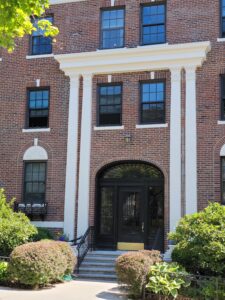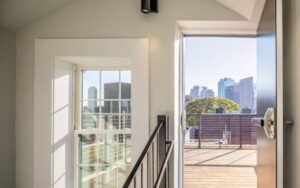By Kieran Fitzgibbon
“Rust never sleeps.”
Neil Young
Most property managers, like most Americans, have worked from home throughout the pandemic. But wind, rain, snow, ice and hot sun have been on-site through it all, wearing down even the best-constructed buildings.
Some property managers continued their long-term maintenance projects during the pandemic, but most conducted only essential repairs, according to a survey by Real Estate Bees. Property managers surveyed said delayed maintenance has caused the greatest negative impact of any factor during the pandemic.
Property managers had little time to address long-term maintenance projects, as following ever-changing COVID protocols, while keeping residents, visitors and employees safe, was added to their usual responsibilities.

A deteriorating portico made from stamped concrete was replaced with this fiberglass entryway, updating the appearance and saving money.
But there were other reasons for delaying maintenance. According to the survey by Real Estate Bees, residents frequently would not allow workers into their units, fearing that doing so would put their health at risk. The survey also noted that, “Due to physical distancing protocols, property management companies have chosen to suspend annual renewal evaluations of properties.”
Unfortunately, maintenance was curtailed at a time when it may have been most needed. With nearly 70% of full-time workers working from home during the pandemic, according to a survey by Owl Labs, condominiums and apartment buildings likely experienced more wear and tear than usual.
Post-Pandemic Challenges
COVID-19 has not gone away, but it’s no longer an all-consuming crisis, so many property managers are seeking to catch up with delayed maintenance projects.
Yet the pandemic has spawned other crises that continue to affect property maintenance. Supply chain issues have led to a shortage of many materials and a lack of qualified labor continues to add to delays.
Meanwhile, the cost of materials is rising rapidly. Inflation is up 8.5% over the past year, but the costs of some goods has escalated even faster. Lumber prices, for example, soared from $349 per thousand board feet in April 2020 to $1,514 in May of 2021, according to Fastmarkets’ Random Lengths. During the past year, prices have ranged from $468 to $1,670.50.
And, of course, housing prices have soared. Home prices rose 16.9% in 2021, according to the National Association of Realtors.
There are also an increasing number of regulatory obstacles. For example, the May issue of Condo Media reported that Fannie Mae and Freddie Mac have developed new lending guidelines in response to the collapse of a high-rise condominium in Surfside, Fla., that killed nearly 100 people.
Under the new guidelines, associations that defer maintenance will risk having lending declined. They will also assume significant liability, as the guidelines shift risk from lenders to associations and property managers.
Catching Up
Given these challenges, how can you catch up on building maintenance in today’s economy? And how can you stay on budget and on schedule?
Spend more time on site. Many project managers continue to work from home, but managing property remotely is like raising kids remotely. It can’t be done effectively, because some things require personal contact.
It takes an up-close, under-the-microscope inspection for managers to identify small maintenance issues before they become big maintenance issues. Being on site, you may also hear directly from residents about maintenance problems about which you may not have been aware.
Schedule an inspection of the building envelope. While simply being on site may help identify some maintenance issues, an inspection by an expert will go deeper. A thorough inspection by a structural engineer or building envelope consultant will not only identify existing problems, it will identify causes of the problems and recommend fixes for them.
An inspection may also save money long-term by identifying simple maintenance, such as cleaning, repainting and resealing, that can slow corrosion and wear. Such repairs will make your building look better, while enabling it to go longer without major repairs.
Property managers typically schedule annual or biannual ro of inspections, but it’s critical to keep the entire envelope well maintained. Façades merit the same level of scrutiny as roofs. In one recent case, a building continued to leak after the roof was replaced, because moisture was intruding into the building through the exterior walls, which were constructed of masonry.
Ideally, the roof and façade of a building should be inspected annually.
Plan ahead. Even before the pandemic, maintenance projects were time consuming.
Getting bids, having typically three engineering companies on site, then completing an engineering study takes a great amount of time. Everything from the environmental impact to the materials being used must be considered and a budget must be developed.
Completing this work up front, well before you even intent to begin the project, will save time. You’ll be ready to proceed when you want to proceed.
Develop a maintenance plan. If you’ve delayed maintenance because of the pandemic, you likely have more projects than you can handle in a year. You’ll need to perform a maintenance triage by identifying and prioritizing all of your projects.
Attach a price to each and determine what you can accomplish in the year to come. Budget to the best of your ability, but keep in mind that prices are going up rapidly.
Don’t delay. Be proactive. Take action now. Inflation isn’t going away anytime soon, so the cost of property repairs or upgrades may be significantly higher a year or two from now.
That’s not the only reason to act now. Quality vendors are likely to be fully booked, and some materials and products are likely to continue to be difficult to obtain, for the near future at least. Even if materials are available, work may be delayed for months.
Think creatively. If you’ve planned ahead sufficiently, even hard-to-find materials may be obtained, but that’s not always the case.
What can you do if the materials you need are unavailable? Perhaps the design can be simplified or a material can be replaced. You may even find a better or less expensive design. For example, we recently replaced a portico that was becoming unsafe with a fiberglass cornice that is aesthetically pleasing, durable and affordable.

An engineer initially thought the fifth floor of this building would have to be replaced, but it was salvaged and the rooftop was made into an attractive area.
Consider energy efficiency. If you’re planning a significant project, using energy efficient materials can help ensure a quick return on investment – especially given the huge increase in energy costs we’ve experienced this year. Energy efficiency is also a great advantage when you’re marketing the property. It will continue to be important even if oil prices drop.
Use experienced vendors. Choosing contractors for your maintenance projects is more important than ever. Check references and hire experienced vendors who have retained quality workers and supply chains that are relatively intact.
If you’ve neglected maintenance during the pandemic, it’s time to catch up. If you’ve been able to continue to maintain the property you manage, it’s no time to let up. As Neil Young said, “Rust never sleeps.”
Kieran Fitzgibbon is co-owner of Statewide RM of Brighton, Mass., which specializes in masonry restoration for condominiums. He can be reached at kfitzgibbon@statewiderm.com.
